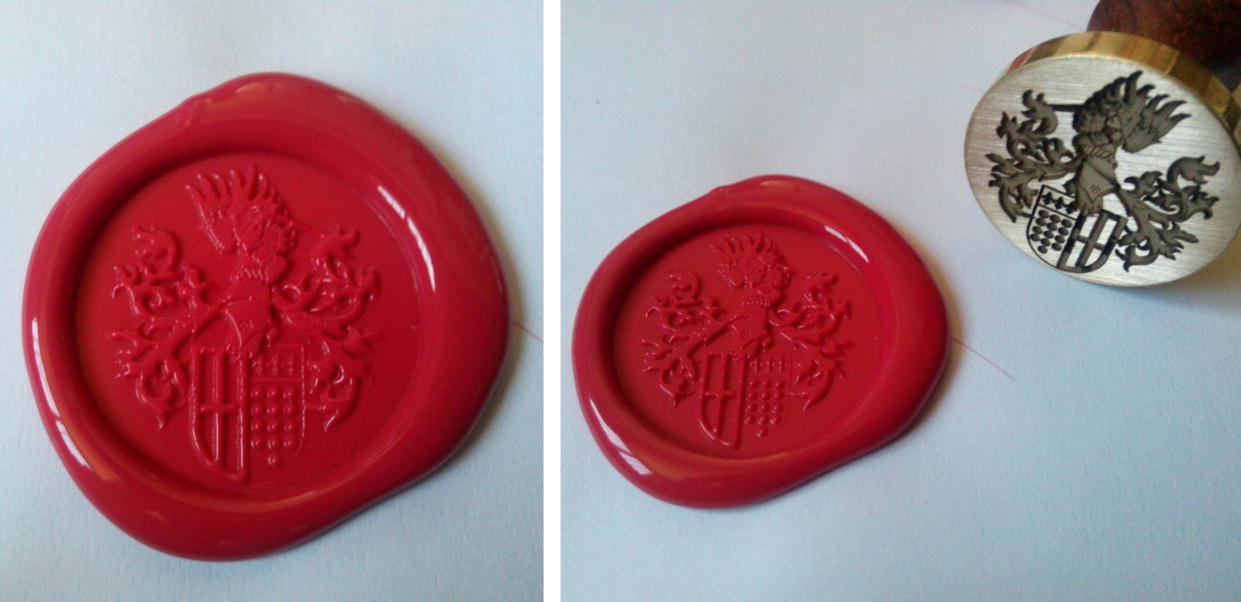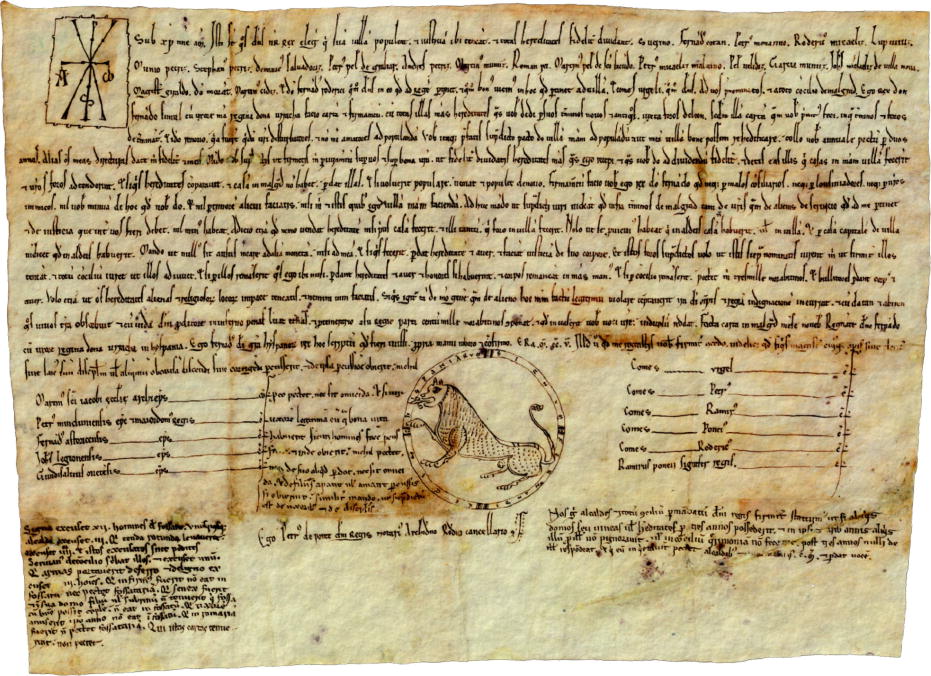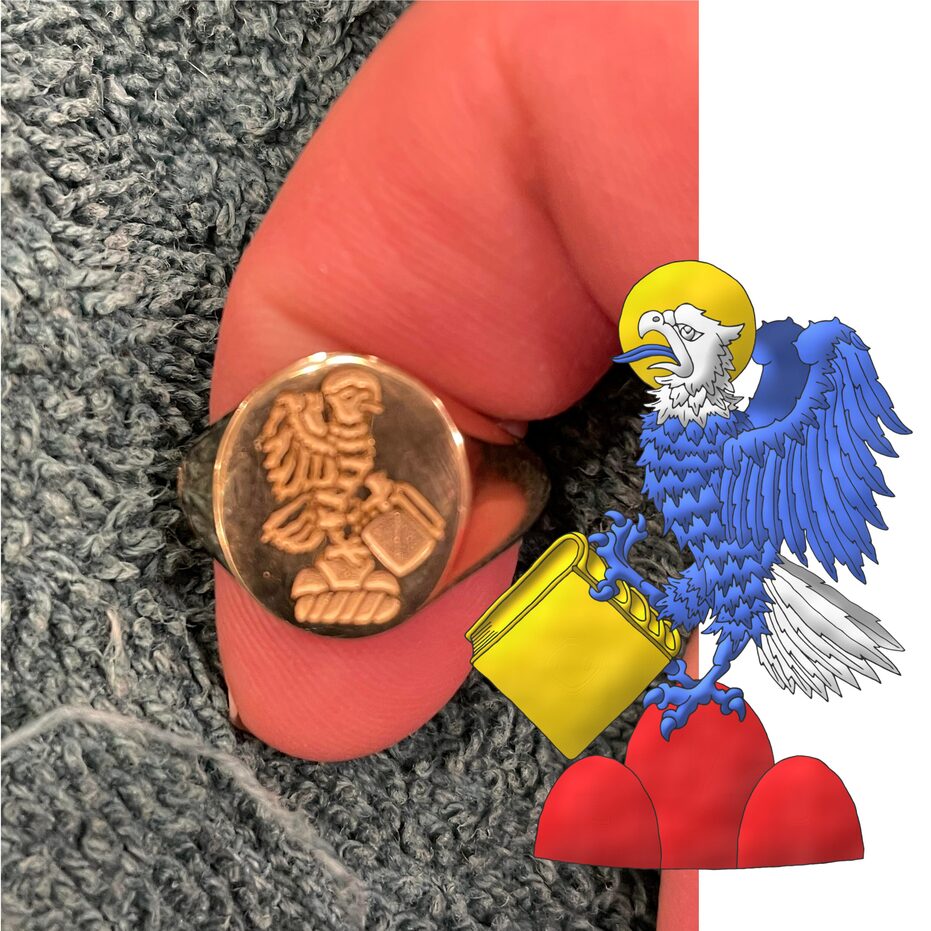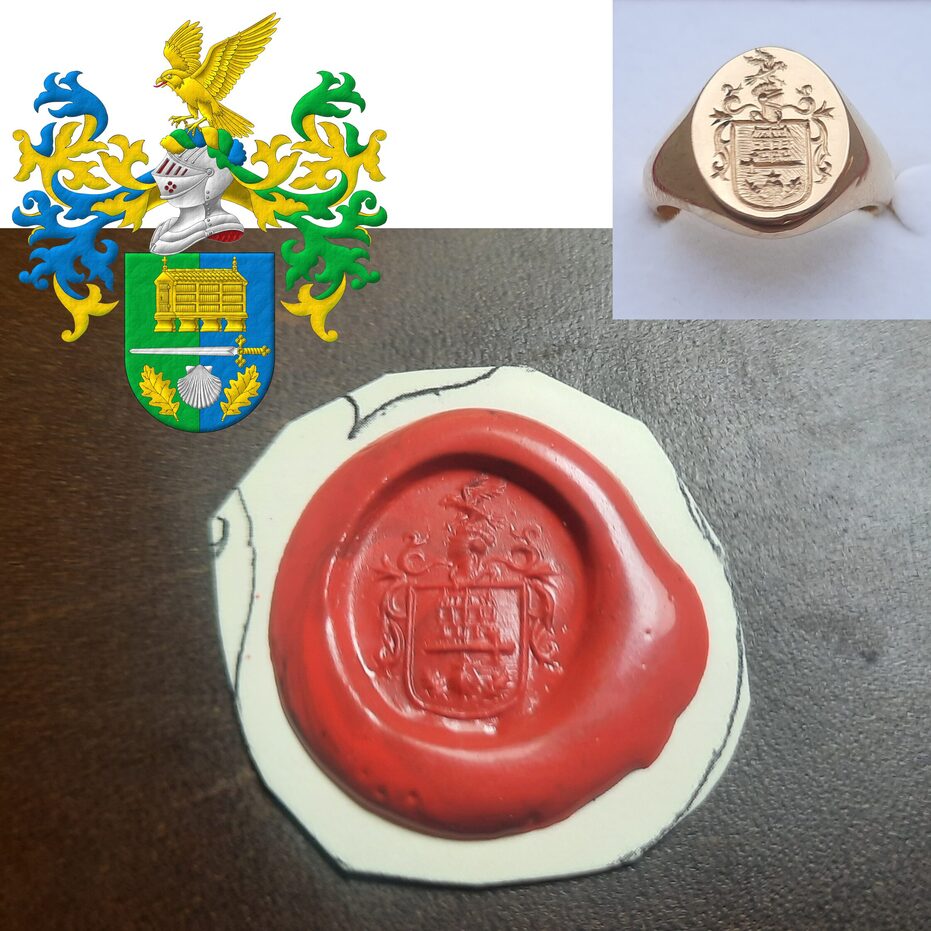Seal


Carlos Vidriales, seal and sealing wax
Credits: Carlos Vidriales commissioned this wax seal from my interpretation of his arms.
Category: Seal.
Root: Vidriales García y Bustamante, Carlos.


Ferdinand II of Leon
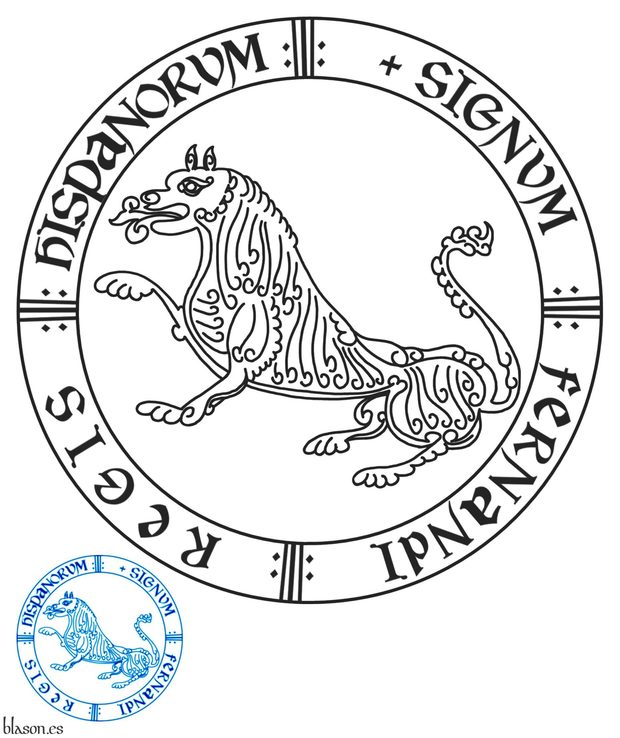
Round seal, a lion sejant. Circular motto: «Signum Fernandi Regis Hispanorum».
Sello rodado, un león sentado. Divisa circular: «Signum Fernandi Regis Hispanorum».
Existing seal interpreted by me as follows: the shape of the seal is circular; the motto is written in sable on its outer ring; inside, a seated lion that begins to be rampant and will eventually become so; y the whole rendered in flat sable ink; y the result is an impression in azure ink.
For the outline of the lion I have followed the round seal of the king in his «Charter of Benavente» [Fernando II de León; 1167], in which I consider the lion to be seated; although it could also be interpreted as rampant, or as intending to be so, as it will ultimately appear in the arms of his son, King Alfonso IX of León.
For the delineation of the motto I have followed the round seal of the king in his «Charter of the Alfoz of Benavente» [Fernando II de León; 1181], in which the lion, unlike the previous one, is clearly in a passant posture.
In [Martín Fuertes, J. A.; 2002] four other round seals of King Fernando II of León can be consulted:
- from the year 1160 (A.C. de León, number 4168) with a lion passant,
- from the year 1165 (A.C. de León, number 1041) with another lion passant,
- from the year 1168 (A.C. de León, number 170) with a lion statant, also described as arrested or at rest, as mentioned in [Avilés, J.; 1725a; page 37] and [Avilés, J.; 1780a; page 42].
- from the year 1187 (A.C. de León, number 1067) with a lion passant and regardant, that is, with its head turned toward the sinister side of the round seal, a posture described, for example, in [Avilés, J.; 1725a; page 55] and [Avilés, J.; 1780a; page 61].
In attitudes of the lion of Ferdinand II the attitudes discussed in this article are illustrated.
Blazon keywords: Without divisions, One, Lion, Sejant and Motto (identification).
Style keywords: Round, Plain tincture and Sealed.
Classification: Interpreted, Personal, Seal and Kingdom of León.
Bearer: Ferdinand II of Leon.


Ferdinand II, Signum Regis Hispanorum
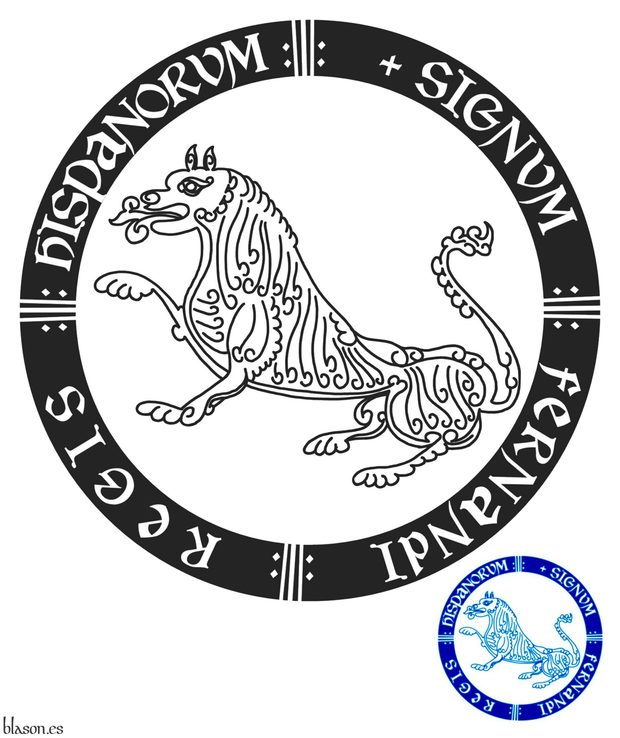
Born in 1137, King of León from 1157 to 1188, died in Benavente on January 22, 1188.
Round seal, a lion sejant. Circular motto: «Signum Fernandi Regis Hispanorum».
Sello rodado, un león sentado. Divisa circular: «Signum Fernandi Regis Hispanorum».
Existing seal interpreted by me as follows: the shape of the seal is circular; the legend is written within an outer black border; inside, a seated lion, not so much rampant and even less passant; the whole rendered in flat sable ink; and the result glazed with azure ink.
I use the term "legend" for its identifying purpose regarding King Fernando II of León; note that among the terms motto, legend, device, and war cry, all referring to texts in the blazon, different nuances and meanings can be found.
Blazon keywords: Without divisions, One, Lion, Sejant and Motto (identification).
Style keywords: Round, Plain tincture and Sealed.
Classification: Interpreted, Personal, Seal and Kingdom of León.
Bearer: Ferdinand II of Leon.


![Ver [Fernando II de León; 1167] en referencias bibliográficas. Libro abierto, hojas de plata, filo de oro, guardas de gules, tapas de sable.](../css/Libro.Bibliografia.png)
Fernando II de León; 1167

Fernando II, King of León, «Carta Puebla de Benavente», Historical Archive of the City Council of Benavente, dated November 1167.
It is a document in which King Fernando II of León grants privileges to Benavente with the aim of repopulating this town.
The original document is a parchment measuring 60 x 43 centimeters, adorned in the upper right corner, right according to the heraldic criterion, with a Chi Rho from which hang an alpha and an omega. In what could be considered the navel of the charter is a rolled seal of the king formed by a lion, which I consider closer to rampant than passant, surrounded by a circular motto that reads «Signum Fernandi Regis Hispanorum» ~ «Sign of Fernando, King of the Spains». Additionally, this rolled seal is accompanied by the names of members of the chancery and prelates of the Kingdom of León, to confirm the grants recorded in the «Carta Puebla de Benavente».
This charter, also called the «Fuero de Benavente», is a beautiful example of local law and, since its promulgation in 1167, served as a model for other towns. In the following years, similar charters to that of Benavente were adopted in other towns of León, Asturias, and Galicia, with the one in La Coruña being a notable example.
The objective of the provisions of this charter was to favor the repopulation and settlement of new settlers in the town of Benavente, and its successful operation in this aspect led to its application in other places.
The original document is kept in the Municipal Archive of Benavente, forming part of its collection of royal privileges of Benavente. There is also a «facsimile» edition, like the one that illustrates this bibliographic reference, published in 2002 by the Benavente City Council on the occasion of the Commemoration of the VIII Centenary of the Benavente Courts.
Bibliographical reference of century XII.
Author: Fernando II de León.
Here are the articles quoting this reference:
External resources:
- Benavente remembers Fernando II of León.
- Churches in the parish of Renueva.
- Facsimile of the Carta Puebla de Benavente.
- Carta Puebla in PDF.
Internal resources: FernandoII.24.Facsimil.CartaPueblaBenavente.pdf in armorial, Fernando II of León, key 104..


Fernando Marán Bié, The Armorial Register
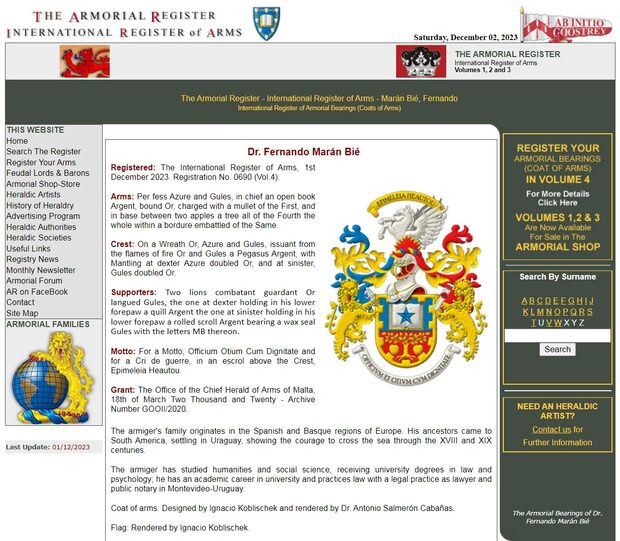
Registered by The International Register of Arms, 1st of December of 2022, Registration number 0690, Volume 4.
In Spanish heraldry, there are three terms for supporters: «sostenes» for objects or plants, «tenantes» for human figures, and «soportes» for animal forms. The following applies to sostenes, tenantes, and soportes. Unlike other heraldic traditions such as English heraldry, in Spanish heraldry there are no rules for the use of supporters; their use is at the armiger's discretion, without specific restrictions. Supporters are not reserved only for nobility; their use is free for all.
In the words of [Cadenas y Vicent, V. de; 1975; page 173] «there is no rule that determines the use of tenantes, soportes, and sostenes».
Categories: Armorial roll, Party per fess, Azure, One, Book, Open, Or, Leaved, Argent, Charged, Mullet, Gules, Tree, Erased, Between, Two, Apple, Diminished bordure, Embattled, Crest and mantling, Helm, Fimbriated, Wreath, Mantling, Dexter, Sinister, Crest, Pegasus, Rampant, Nascent, Flame, Supporter (animal), Supporter, Lion, Langued, Quill, Claw, Parchment (scroll), Rolled, Seal, Letter, War cry and Motto.
External resource:
Root: The Armorial Register.


Latidos Podencos, seal of the animal protection organization
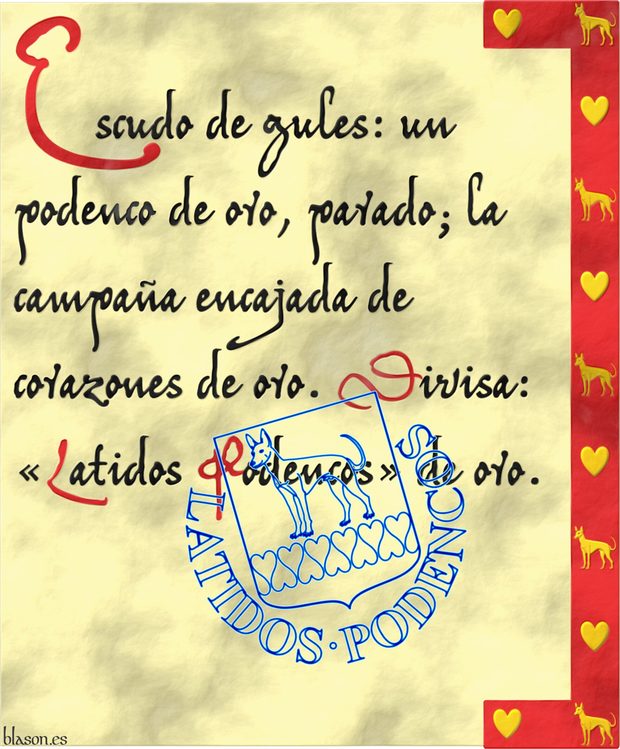
Protectora del podenco español.
I have created the seal of the shelter Latidos Podencos based on its coat of arms.
[Avilés, J.; 1780a; page 79, third paragraph from the beginning] writes that «Encaxadas, or emananchadas», from the French «émanche», and in English sometimes rendered as «emanche» and other times described as «line of», refers to «those partitions of the shield whose pieces fit one into another in the form of thick and elongated triangles, which are usually one-third of the length or width of the shield, depending on the direction in which these figures are placed in a per pale, per fess, per bend, or per bend sinister division, etc. But when it is a chief, they have half the base and the rest pointed; and if it is a fess, it is formed by alternating triangles filling it entirely». This description corresponds to the most general form of the «encajado», although there may be other ways to position it —in this case, in the base— and other types of «encajado» depending on the figures represented, such as those made of fir trees, Latin crosses, or, as in this case, of hearts.
Blazon keywords: Without divisions, Dog, Base, Dancetty, Heart and Motto (identification).
Classification: Seal, Created and Socioeconomic.
Bearer: Latidos Podencos.


Seal of Herbert Leo Buffenbarger
Upon a wreath Argent and Azure, upon a trimount Gules, an eagle wings addorsed and inverted Azure, the head and tail Argent, nimbed Or, grasping a closed book also Or.
The signet ring featuring the crest of the arms of Herbert Leo Buffenbarger, based on his heraldic crest. The crest was designed by his son, John Alan Francis Buffenbarger, and emblazoned by me. The image shows the signet ring featuring the crest upon a wreath, alongside my painting of the crest upon which the ring is based.
Blazon keywords: Crest, Argent, Azure, Gules, Or, One, Three, Upon (wreath), Wreath, Upon, Trimount, Eagle, Wing, Addorsed, Head, Tail, Nimbed, Grasping, Closed book and Book.
Style keywords: Outlined in sable and Illuminated.
Classification: Personal, Interpreted, Boa, Seal, Collage and Photographic.
Bearer: Buffenbarger, Herbert Leo.


Seal of Jesús Jesus Angueira Duro
Per pale Vert and Azure, overall a sword fesswise Argent, hilted Or, between in chief a Galician granary Or, and in base an escallop Argent between two oak leaves in pile Or. Crest: Upon a helm, with a wreath Or, Vert, and Azure a falcon rising Or, langued Gules. Mantling: dexter Azure doubled Or, sinister Vert doubled Or.
Signet ring engraved in mirror and red wax seal impression, based on the design of the coat of arms of Jesús Angueira Duro from Galicia, created by him and me, and painted by me.
Blazon keywords: Vert, Azure, Or, Argent, One, Two, Party per pale, Overall, Sword, Fesswise, Hilted, Between, In chief, Galician granary, In base, Escallop, Oak, Tree, Leaf, In pile, Crest and mantling, Crest, Upon (wreath), Helm, Wreath, Falcon, Rising, Langued, Mantling, Dexter, Doubled and Sinister.
Style keywords: Outlined in sable, Illuminated, Semi-circular and Sealed.
Classification: Personal, Created, Boa, Seal, Collage and Photographic.
Bearer: Angueira Duro, Jesus.
-
Language
-
Categories of heraldry
-
Divisions of the field
- Without divisions
- Party per pale
- Party per fess
- Party per bend
- Party per bend sinister
- Tierce
- Tierce sinister
- Tierced per pale
- Tierced per fess
- Tierced per bend
- Tierced pallwise inverted
- Quarterly
- Quarterly per saltire
- Gyronny
- Party per fess, the chief per pale
- Party per pale, the sinister per fess
- Party per fess, the base per pale
- Party per pale, the dexter per fess
- Chapé
- Chaussé
- Embrassé
- Contre-embrassé
- Party per chevron
- Enté
- Enté en point
- Flanched
-
Metals
-
Colours
-
Furs
-
Other tinctures
-
Ordinaries and sub-ordinaries
-
Diminutives of the ordinaries
-
Geometric charges
-
Composite ordinaries
-
Inanimate charges from Nature
Atom, Crescent, Diamond, Emerald, Estoile, Increscent, Lightning flash, Moon, Mount, Mullet, Mullet of four points, Orbital, Plough of Ursa Major, Rainbow, Ray of the sun, River, Sea, Snowflake, Sun, Sun in splendour, Sun of May, Trimount and Water.
-
Vegetal charges from Nature
Acorn, Apple, Apple tree, Ash, Bluebonnet, Camellia, Chrysanthemum, Cinquefoil, Cornflower, Dogwood flower, Double rose, Elm, Fleur de lis, Flower, Holm oak, Hop cone, Kapok tree, Laurel, Lily, Linden, Lotus flower, Madonna lily, Oak, Olive tree, Palm tree, Pomegranate, Poplar leaf, Rose, Shamrock, Sunflower, Thistle, Tree, Tulip, Vine and Wheat.
-
Animal charges from Nature
Badger, Bald eagle, Barbel, Barn owl, Bear, Beaver, Beetle, Bighorn sheep, Blackbird, Boar, Brach hound, Bull, Doe, Dog, Dolphin, Dove, Eagle, Elephant, Falcon, Fish, Flame, Fly, Fox, Frog, Goat, Goldfinch, Goose, Heron, Horse, Hummingbird, Jaguar, Lark, Leopard, Lion, Lion passant, Lion rampant guardant, Lioness, Lynx, Male figure, Martlet, Merino ram, Owl, Panther, Parrot, Peacock, Pelican, Pelican in her piety, Puffin, Quetzal, Raven, Roe deer, Rooster, Savage, Seagull, Serpent, She-wolf, Stag, Starling, Talbot, Tyger, Vulture, Warren hound and Wolf.
-
Parts of natural charges
Arm, Beak, Branch, Caboshed, Chest, Claw, Covert, Dorsal fin, Eagle claw, Ermine spot, Escallop, Feather, Foot (palmiped), Foreleg, Forepaw, Hand, Head, Heart, Hoof, Leaf, Neck, Ostrich feather, Palm frond, Paw, Roe deers' attires, Shoulder, Sprig, Stags' attires, Stem, Swallow-tail, Tail, Tail addorsed, Tail fin, Talon, Tooth, Trunk, Trunk (elephant), Two hands clasped, Two wings in vol, Udder, Wheat spike, Wing and Wrist.
-
Artificial charges
Ace of spades, Anchor, Anvil, Arch, Arm vambraced, Armillary sphere, Arrow, Axe, Bell, Bell tower, Beret, Bonfire, Book, Bookmark, Bow, Bridge, Broken, Buckle, Cannon, Cannon dismounted, Cannon port, Canopy roof, Carbuncle, Castle, Celtic Trinity knot, Chain, Chess rooks, Church, Clarion, Clay pot, Closed book, Club, Comb, Compass rose, Conductor's baton, Cord, Covered cup, Crozier, Crucible, Cuffed, Cup, Cyclamor, Dagger, Double vajra, Drum, Ecclesiastical cap, Fanon, Federschwert, Fleam, Four crescents joined millsailwise, Galician granary, Garb, Gauntlet, Geometric solid, Grenade, Halberd, Hammer, Harp, Host, Hourglass, Key, Key ward, Knight, Knot, Lantern, Letter, Line, Loincloth, Menorah, Millrind, Millstone, Millwheel, Monstrance, Mortar, Mullet of six points pierced, Nail, Non-classic artifact, Norman ship, Number, Oar, Oil lamp, Open book, Page, Pair of scales, Parchment, Pestle, Piano, Plough share, Polish winged hussar, Port, Portcullis, Potent, Quill, Ribbon, Rosette of acanthus leaves, Sabre, Sackbut, Sail, Scroll, Scythe, Sheaf of tobacco, Ship, Skirt, Spear, Spear's head, Stairway, Star of David, Step, Sword, Symbol, Tetrahedron, Torch, Tower, Trident, Trumpet, Turret, Two-handed sword, Wagon-wheel, Water-bouget, Wheel, Winnowing fan and With a turret.
-
Immaterial charges
Angel, Archangel, Basilisk, Dragon, Dragon's head, Garuda, Golden fleece, Griffin, Heart enflamed, Mermaid, Our Lady of Mercy, Ouroboros, Paschal lamb, Pegasus, Phoenix, Sacred Heart of Jesus, Saint George, Sea-griffin, Trinity, Triton, Unicorn, Winged hand and Wyvern.
-
External elements
-
Heraldic creations
-
References
-
Formats
-
Keywords on this page
Open, Between, Addorsed, Embattled, Angueira Duro, Jesus, Armorial roll, Erased, Rising, Azure, Bibliography, Boa, Overall, Buffenbarger, Herbert Leo, Wreath, Head, Base, Upon (wreath), Crest, Round, Collage, Created, Outlined in sable, Dexter, Motto (identification), Two, Sealed, Ferdinand II of Leon, Photographic, Personal, Gules, Illuminated, Interpreted, Mantling, Langued, Lion, Book, Or, Argent, Without divisions, Rampant, Kingdom of León, Seal, Sejant, Sinister, Crest and mantling, Plain tincture, One, Helm and Tree.

